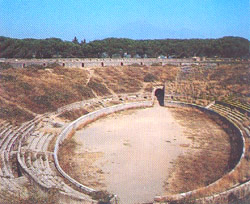
AMPHITHEATRE - POMPEII

The term amphitheatre is literally defined as the space for the spectators that runs all round the arena. The commemorative inscription attributes its construction to the highest officials in Pompeii, Caius Quintus Valgus and Marcus Portius, who also built the Odeion shortly after the town had acquired the status of Roman colony. The Pompeian Amphitheatre is classed as the oldest of all existing buildings of this kind. To allow easy access, it was built in an area on the outskirts of the town with comparatively few buildings and it was inserted into a corner formed by the town walls in order to make use of the existing embankments on two of its sides. About 20000 people could be seated in its three tiers and would attend bloody shows performed by gladiators and wild animals. No shows were held in the amphitheatre in the winter months and in the warmest period of the year. In the summer, a canopy of dark flax material was fitted above the seats to protect the audience from the burning sun and this was advertised in the notices announcing the shows. The canopy was supported on wooden poles inserted into stone rings fixed to the walls on the upper landings of the stairways. A number of external stairways led to the upper tiers (summa cavea) which formed the top part of the structure. From a passageway running parallel to the perimeter of the arena, and from here over several stairways, the spectators could reach the middle and lower tiers (ima cavea and media cavea). Carts would enter the amphitheatre through two corridors which led to the slightly flattened ends of the arena directly from outside. The wild animals used for the shows entered the arena through a narrow passage in th emiddle of the arena.





